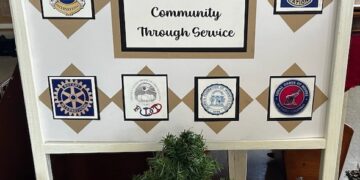On April 17, 1999, a dream became reality for many in the southern gospel music industry – the Southern Gospel Music Hall Of Fame & Museum opened at the Dollywood theme park in Pigeon Forge, Tennessee. Last month we chronicled the challenges the Southern Gospel Music Association (SGMA) faced in constructing a facility, and this month I’ll take you on a brief walking tour of the museum as it was at Dollywood for just over twenty years.
As I mentioned last month, the deal was almost ‘too good to be true’ for the SGMA: Dollywood would construct the museum facility, and the SGMA would then be responsible for the interior design and exhibits. Jim Goff, a history professor at Appalachian State University, had recently published an extensive history of southern gospel music. Goff worked with 1220 Exhibits of Nashville, TN, to create the ‘storyline’ for the museum.
The layout was simple. The actual Hall Of Fame would be an oval-shaped room in the center of the building. Guests would enter the museum and move counter-clockwise around the Hall Of Fame, before exiting through a gift shop.
Entering the museum (which was located just inside Dollywood’s main entrance, beside the Showstreet Palace Theater), guests would find themselves in an area entitled The Roots Of Southern Gospel. The focal point of this display was an elevated stage with an animatronic quartet demonstrating not just four-part harmony, but also shape-note-singing. This short presentation featured three songs, including “Give The World A Smile” and “Rock Of Ages”. Unbeknownst to guests, the animatronics were voiced by Greater Vision (Gerald Wolfe, Rodney Griffin, and Jason Waldroup), accompanied by bass singer Bob Caldwell.
Continuing past The Roots Of Southern Gospel, visitors entered The Early Quartets area, which was devoted to the time period leading up to World War II. Many songbooks (printed in shape-note, of course), were on display, for this was the foundation of southern gospel music as we know it today. Publishing companies would organize quartets to sing from – and thus, promote – their songbooks. Also on display were a good number of 78 rpm records from the 1920s and 1930s, some of the earliest southern gospel recordings.
Perhaps the most vividly remembered section of the museum occupied the back wall: The Good News Travels Fast. Here on display was a full-size 1938 Aerocoach bus, which the Blackwood Brothers converted into the very first quartet tour bus in 1955. Originally, guests could walk through the bus, but it was later stanchioned off. (The bus was not the actual Blackwood Brothers bus – whose whereabouts are unknown – but rather a faithful replica).
We’ll continue our walking tour next month, as we visit The Golden Age Of Quartets, and The New Millennium sections. We’ll also discuss the museum’s later years, and its eventual relocation to the Biblical Times Dinner Theater on the parkway in Pigeon Forge.


































